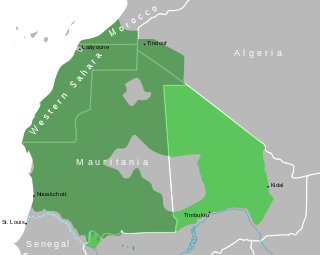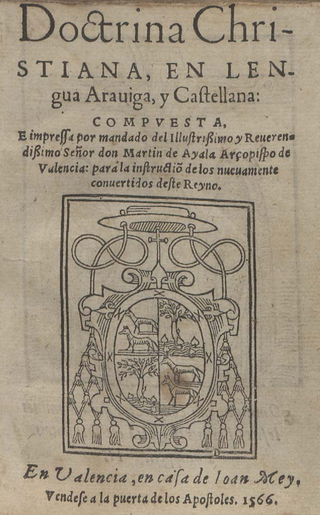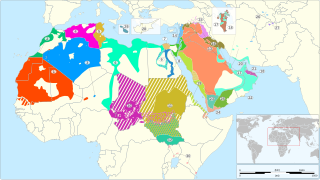Related Research Articles

Arabic is a Central Semitic language of the Semitic language family spoken primarily in the Arab world. The ISO assigns language codes to 32 varieties of Arabic, including its standard form of Literary Arabic, known as Modern Standard Arabic, which is derived from Classical Arabic. This distinction exists primarily among Western linguists; Arabic speakers themselves generally do not distinguish between Modern Standard Arabic and Classical Arabic, but rather refer to both as al-ʿarabiyyatu l-fuṣḥā or simply al-fuṣḥā (اَلْفُصْحَىٰ).

Hassaniya Arabic is a variety of Maghrebi Arabic spoken by Mauritanian Arabs and the Sahrawi people. It was spoken by the Beni Ḥassān Bedouin tribes of Yemeni origin who extended their authority over most of Mauritania and Morocco's southeastern and Western Sahara between the 15th and 17th centuries. Hassaniya Arabic was the language spoken in the pre-modern region around Chinguetti.

Andalusi Arabic or Andalusian Arabic was a variety or varieties of Arabic spoken mainly from the 9th to the 15th century in Al-Andalus, the regions of the Iberian Peninsula, respectively modern Spain until the late-15th century, and modern Portugal until the mid-13th century under Muslim rule. It became an extinct language in Iberia after the expulsion of the Moriscos, which took place over a century after the Granada War by the Catholic Monarchs of Spain. Once widely spoken in Iberia, the expulsions and persecutions of Arabic speakers caused an abrupt end to the language's use on the peninsula. It continued to be spoken to some degree in North Africa after the expulsion, although Andalusi speakers rapidly assimilated into the Maghrebi communities to which they fled.

Yemeni Arabic is a cluster of varieties of Arabic spoken in Yemen and southwestern Saudi Arabia. It is generally considered a very conservative dialect cluster, having many classical features not found across most of the Arabic-speaking world.
While many languages have numerous dialects that differ in phonology, the contemporary spoken Arabic language is more properly described as a continuum of varieties. This article deals primarily with Modern Standard Arabic (MSA), which is the standard variety shared by educated speakers throughout Arabic-speaking regions. MSA is used in writing in formal print media and orally in newscasts, speeches and formal declarations of numerous types.

Gulf Arabic is a variety of the Arabic language spoken in Eastern Arabia around the coasts of the Persian Gulf in Kuwait, Bahrain, Qatar, the United Arab Emirates, southern Iraq, eastern Saudi Arabia, northern Oman, and by some Iranian Arabs.

Najdi Arabic is the group of Arabic varieties originating from the Najd region of Saudi Arabia. Outside of Saudi Arabia, it is also the main Arabic variety spoken in the Syrian Desert of Iraq, Jordan, and Syria as well as the westernmost part of Kuwait.

Hejazi Arabic or Hijazi Arabic (HA), also known as West Arabian Arabic, is a variety of Arabic spoken in the Hejaz region in Saudi Arabia. Strictly speaking, there are two main groups of dialects spoken in the Hejaz region, one by the urban population, originally spoken mainly in the cities of Jeddah, Mecca, Medina and partially in Ta'if and another dialect by the urbanized rural and bedouin populations. However, the term most often applies to the urban variety which is discussed in this article.
The phonology of Bengali, like that of its neighbouring Eastern Indo-Aryan languages, is characterised by a wide variety of diphthongs and inherent back vowels.
Kuwaiti is a Gulf Arabic dialect spoken in Kuwait. Kuwaiti Arabic shares many phonetic features unique to Gulf dialects spoken in the Arabian Peninsula. Due to Kuwait's soap opera industry, knowledge of Kuwaiti Arabic has spread throughout the Arabic-speaking world and become recognizable even to people in countries such as Tunisia and Jordan.

Ṣaʽīdi Arabic, or Upper Egyptian Arabic, is a variety of Arabic spoken by the Upper Egyptians in the area that is South/Upper Egypt, a strip of land on both sides of the Nile that extends from Aswan and downriver (northwards) to Lower Egypt. It shares linguistic features with Egyptian Arabic, Modern Standard Arabic, and the Classical Arabic of the Quran. Dialects include Middle and Upper Egyptian Arabic.

Varieties of Arabic are the linguistic systems that Arabic speakers speak natively. Arabic is a Semitic language within the Afroasiatic family that originated in the Arabian Peninsula. There are considerable variations from region to region, with degrees of mutual intelligibility that are often related to geographical distance and some that are mutually unintelligible. Many aspects of the variability attested to in these modern variants can be found in the ancient Arabic dialects in the peninsula. Likewise, many of the features that characterize the various modern variants can be attributed to the original settler dialects as well as local native languages and dialects. Some organizations, such as SIL International, consider these approximately 30 different varieties to be separate languages, while others, such as the Library of Congress, consider them all to be dialects of Arabic.
Himyaritic is an unattested or sparsely attested Semitic language that was spoken in ancient Yemen, by the Himyarite tribal confederacy. It was a Semitic language but either did not belong to the Old South Arabian (Sayhadic) languages according to Christian Robin or was, as more widely accepted, not a distinct language from Sabaic. The precise position inside Semitic is unknown because of the limited knowledge of the language if it is indeed a distinct language from Sabaic.
Western Egyptian Bedawi Arabic, also known as Sahil Maryut Bedouin Arabic, is a group of Bedouin Arabic dialects spoken in Western Egypt along the Mediterranean coast, west to the Egypt–Libya border. Ethnologue and Glottolog classify Western Egyptian Bedawi Arabic as a Libyan Arabic dialect.
Razihi, originally known to linguists as "Naẓīri", is a Central Semitic language spoken by at least 62,900 people in the vicinity of Mount Razih in the far northwestern corner of Yemen. Along with Faifi, it is possibly the only surviving descendant of the Old South Arabian languages.
PalatalizationPA-lə-tə-leye-ZAY-shən is a historical-linguistic sound change that results in a palatalized articulation of a consonant or, in certain cases, a front vowel. Palatalization involves change in the place or manner of articulation of consonants, or the fronting or raising of vowels. In some cases, palatalization involves assimilation or lenition.
This article is about the phonology of Levantine Arabic also known as Shāmi Arabic, and its sub-dialects.
The phonological system of the Hejazi Arabic consists of approximately 26 to 28 native consonant phonemes and 8 vowel phonemes:. Consonant length and vowel length are both distinctive in Hejazi.
Yāfiʿī Arabic is a group of closely related Arabic dialects spoken in the Yāfiʿ district of the Lahij governate in Yemen, in the historical territories of the sheikhdoms of Upper (al-ʿUlyā) and Lower (al-Suflā) Yāfiʿ. Unlike most neighboring dialects the varieties of Yāfiʿ belong to the so-called "k-dialect" grouping, meaning that the second person perfect suffixes retain the /-k/ found in the Sayhadic, Afrosemitic, and Modern South Arabian languages as opposed to the /-t/ found in most Arabic dialects. Before the 1990's the dialects of historical Upper and Lower Yāfiʿ had not been described and thus a number if their features that are seen as distinct from neighboring varieties had been overlooked by previous surveys.

Rijāl Almaʿ is a speech variety of questionable genetic affiliation spoken in the area in and around the village after which it is named, Rijāl Almaʿ. Amongst the features that make this speech variety so distinctive in the area where it is spoken is the seemingly preserved demonstrative pronominal paradigm from the Sayhadic languages and the presence of the a nasal definite article similar to the proposed modern Sayhadic languages Faifi and Razihi. The speech variety is seemingly gradually being phased out due to increased language convergence with neighboring varieties of Arabic, further complicating the situation regarding where this speech variety belongs within Central Semitic.
References
- ↑ Faifi at Ethnologue (25th ed., 2022)

- 1 2 3 Alfaife, Saleem Mohammed (2018). A Grammar of Faifi (Thesis). Long Beach, California: California State University. ISBN 978-0-438-05160-7. ProQuest 2056841951.[ page needed ]
- ↑ Gingrich, Andre (2000-01-01). "Trading autonomy for integration.: Some observations on twentieth-century relations between the Rijâl Alma' tribe and the kingdom of Saudi Arabia". Études rurales (155–156): 75–92. doi:10.4000/etudesrurales.16. ISSN 0014-2182.
- ↑ Alfaifí, Abdullah Ahmad M.; Behnstedt, Peter (2010). "First Notes on the Dialect of Ǧabal Fayfā' (Jazan province/Saudi Arabia)". Zeitschrift für Arabische Linguistik (52): 53–67. JSTOR 10.13173/zeitarabling.52.0053.
- ↑ ISO 639-3 Change Request Documentation: 2019-041, SIL
- ↑ Lowry, Julie. (2020). Language and the negotiation of identity and belonging in Harub, Saudi Arabia. p.67.
- ↑ Alaslani, Khadeejah (2017). A Descriptive Grammar of Fifi (Thesis). OCLC 1004429139. ProQuest 1914912076.[ page needed ]
- ↑ Alfaifi, Abdullah H. (2022). Aspects of the Phonology of a Faifi Arabic Dialect. Indiana University.
{{cite book}}: CS1 maint: location missing publisher (link)